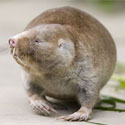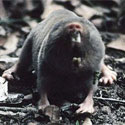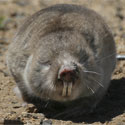|
Family: Bathyergidae (mole-rats)
Life
>
Eukaryotes >
Opisthokonta >
Metazoa (animals) > Bilateria > Deuterostomia >
Chordata > Craniata > Vertebrata (vertebrates) >
Gnathostomata (jawed vertebrates) > Teleostomi (teleost
fish) > Osteichthyes (bony fish) > Class:
Sarcopterygii (lobe-finned fish) > Stegocephalia
(terrestrial vertebrates) > Reptiliomorpha > Amniota >
Synapsida (mammal-like reptiles) > Therapsida > Theriodontia
> Cynodontia > Mammalia (mammals)
> Placentalia (placental mammals) >
Euarchontaglires > Glires > Rodentia (rodents) > Hystricognathi
Species indigenous to southern Africa
|
Bathyergus suillus (Cape dune mole-rat) The Cape Dune mole-rat is the largest completely
subterranean mammal in Africa. It is an active excavator and can push as much as 500 kg of soil to
the surface each month. Dune mole rats are solitary and aggressively territorial,
each animal maintaining its own burrow system that is spaced apart from its
neighbour. The animals rarely venture above ground, but are often forced above
ground during the rainy season when the water table rises. |
 |
|
Bathyergus janetta
(Namaqua dune mole-rat) |
|
|
Cryptomys hottentotus (African mole-rat) |
|
|
Cryptomys damarensis
(Darnaraland mole-rat) |
 |
|
Cryptomys darlingi (Mashona mole-rat) |
|
|
Georychus capensis
(Cape mole-rat) |
 |
|
